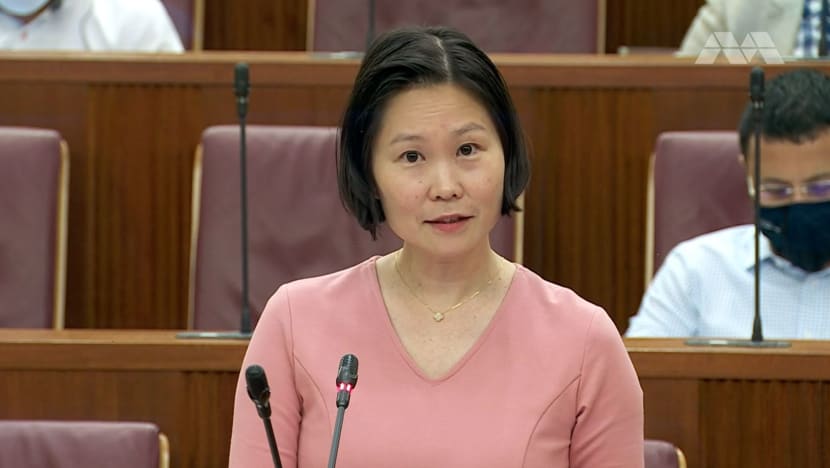Employment rate for Singapore women rose in past decade, share among PMETs also up: MOM

Minister of State for Manpower and for Education Gan Siow Huang speaks in Parliament on Jan 12, 2022.
SINGAPORE: Singapore’s resident female employment rate has increased over the past decade from 54 per cent in 2010 to 57.7 per cent in 2020 and this ranks well compared to OECD countries, said Minister of State for Manpower Gan Siow Huang on Wednesday (Jan 12).
She was replying to parliamentary questions by Ms Cheryl Chan (PAP - East Coast) and Ms Tin Pei Ling (PAP - MacPherson) on job trends for women.
Ms Chan asked for the Ministry of Manpower’s (MOM) observations of emerging trends for female professionals joining emerging industries like digitalisation and sustainability. Ms Tin asked which growth sectors currently see the largest dearth of women talents and leaders, and what are the factors that could have contributed to this gender imbalance.
Ms Gan said that women’s share among professionals, managers, executives and technicians (PMETs) has increased over the decade, from 41.1 per cent to 45.6 per cent.
"We are observing more women joining growth sectors such as the information and communications, financial services, and health and social services," she said. "Altogether, women make up 52.8 per cent in these three sectors."
The share of women in Science, Technology, Engineering and Mathematics (STEM) jobs, while lower, has increased from 29.9 per cent in 2015 to 32.4 per cent in 2020.
A 2019 study on Singapore’s Adjusted Gender Pay Gap found that differences in gender ratios across occupations could be due to gender differences in terms of personality and psychological traits, skills, different values placed on workplace flexibility, as well as social norms, said Ms Gan.
"We will continue to work with our tripartite partners and community stakeholders to support women’s participation in the workforce and help them enter and remain in occupations of their choice, including in emerging sectors."
Ms Gan also addressed questions by Ms Yeo Wan Ling (PAP - Pasir-Ris Punggol) and Ms Joan Pereira (PAP - Tanjong Pagar) on issues that discourage women from taking up formal employment and the impact of caregiving on a caregiver's career, finances and retirement adequacy.
She listed various ways that the Government provides support for caregivers and for families with caregiving needs, such as through subsidised care services and grants.
"These include supporting their caregiving needs directly, enabling working caregivers to better manage both work and their caregiving responsibilities through flexible work arrangements, aiding their re-entry into the workforce through employment facilitation and training support, and strengthening their retirement adequacy," she said.
To a question from Ms Yeo on disputes over flexible work arrangements, Ms Gan said that the Government and tripartite partners are strengthening efforts to encourage the widespread adoption of such arrangements.
In 2021, the Tripartite Alliance for Fair and Progressive Employment Practices did not receive any case relating to such disputes, she said.
Ms Gan said that there is a small proportion of women who have not been able to participate or participate fully in the workforce due to caregiving responsibilities.
In 2020, 15 per cent of women cited family-related responsibilities as their main reason for being outside the labour force, while 6 per cent worked part-time due to family or personal commitments.
"Securing and staying in employment is key to financial resilience and retirement adequacy," said Ms Gan.
"With increasing participation in the workforce and higher wages, successive cohorts have been able to accumulate more CPF savings for retirement today compared to a decade ago."
The Government has also introduced and enhanced measures in recent years to help Singaporeans, including caregivers, build sufficient savings for retirement, she added.
For caregivers who had low incomes during their working years and now have less to retire on, the Silver Support Scheme provides quarterly payouts of up to S$900.
"About two-thirds of the Silver Support recipients are women, including many caregivers," she said.
She gave other examples of help given, such as incentives for caregivers and their loved ones to top up their CPF in cash, and for older caregivers, they can tap on housing monetisation schemes, such as the Lease Buyback Scheme and Silver Housing Bonus.
"The Government will continue to review our multi-pronged efforts to ensure that caregivers are well-supported," said Ms Gan.
















